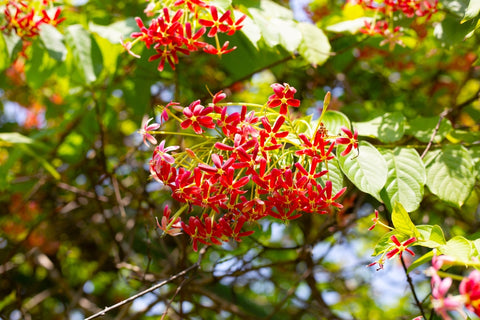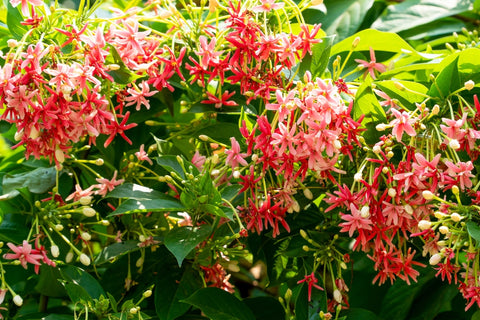In the realm of botanical wonders, there are few plants as beautiful and interesting as Combretum indicum, also known as Rangoon Creeper plant. Going by many names like Burma Creeper, Honeysuckle Plant, Creeping Rangoon, this exotic vine has found its way into the hearts and gardens of plant enthusiasts around the world. In this blog, we explore the origins, growth habits, uses, benefits and more of the Combretum indicum.

• Origins and Global Distribution of the Rangoon Creeper
Combretum indicum or Rangoon Creeper is native to tropical Southeast Asia, especially Burma (now Myanmar), where it is native. Its common name "Rangoon Creeper" pays homage to Burma's former capital of Rangoon, which is now known as Yangon. This vine, which belongs to the Combretaceae family, is known for its unique honeyed malty flowers, which eventually transition from white to pink to red. It is also accompanied by an attractive fragrance that invites many pollinators.
But the Creeping Rangoon's appeal extends far beyond its origins. Adaptive and easy to grow, its roots have spread to tropical and subtropical regions around the world. This resilient plant grows in hot and humid climates and is found in similar climatic conditions in countries like India, Thailand, Philippines, and many other places. Its resilience and ability to grow well in a variety of soils makes it a common sight in residential and commercial gardens.
• Combretum Indicum: Growth and Phases
Rangoon creeper is an exotic woody vine known for its rapid growth. Its botanical name, Combretum indicum, reflects its genetic affinity with the family Combretaceae and its origin in Southeast Asia. The vine is a naturally great climber which makes it a great addition to gardens in need of a natural fence.
The main attraction of the plant is the honey flower which forms tubes and exhibits exotic features. They emerge as white shoots, turn softly pink, and eventually grow into rich red. For garden enthusiasts, this dramatic change in color is a visual delight.

• Benefits and Uses of Rangoon Creeper
1. Ornamental
The main reason for the popularity of Creeping Rangoon is its magnificent honeysuckle flowers. The flowers add rich color and air to any garden, making them a favorite ornamental plant.
2. Scented
The sweet and long-lasting fragrance of the Madhumalti flower not only attracts people but also acts as a magnet for various pollinators. Butterflies, bees and birds are among the most frequent visitors to this natural treasure, adding value to the ecosystem.
3. Potential treatment
In some areas, traditional medicine has used potential drugs against Rangoon creeper. It is believed to be due to the presence of various metabolic compounds in this plant.
4. Madhumalti Flower Has Uses in Cooking
In some cultures, the madhumalti flower is included in cooking. It can be used in salads, desserts and drinks to infuse delicate floral flavors, adding a unique twist to the dining experience.

Buy creepers and climbers
• Other Reasons for its Popularity
In addition to its aesthetics and functions, the popularity of the Rangoon creeper can be attributed to several other factors.
a. Low maintenance
The Madhumalti plant is incredibly low maintenance, making it ideal for novice gardeners. It needs adequate water and is adaptable to different types of soil, helping to grow it more widely.
b. Versatility
Whether it is grown in the ground, in pots, or as a hanging basket plant, the Rangoon Creeper displays its splendor in different settings. This versatility makes it an ideal choice for diverse garden landscapes and designs.
c. Symbolism and Cultural Significance
In addition to its physical allure, the Madhumalti plant holds significant symbolism in various cultures. It is often associated with love, transformation, and beauty, making it a cherished gift for special occasions and celebrations.
d. Eco-Friendly Fencing

The Rangoon Creeper's rapid growth and lush foliage make it an effective and natural choice for creating living fences. Its dense vines provide privacy and serve as an eco-friendly alternative to traditional fencing materials.
e. Insect-Repelling Properties
Some gardeners have found that the Rangoon Creeper can help deter certain insects due to its fragrance. While it may not eliminate pests entirely, it can contribute to a more pest-resistant garden.
Buy Insect Repellent
Simply put, Combretum indicum, has the ability to transcend the definition of a mere plant. It symbolizes natural beauty, change, and tradition. With the wonderful Madhumalti flowers, its ability to thrive in a variety of conditions, and versatility, it has become a favored addition to gardens and landscapes worldwide.














